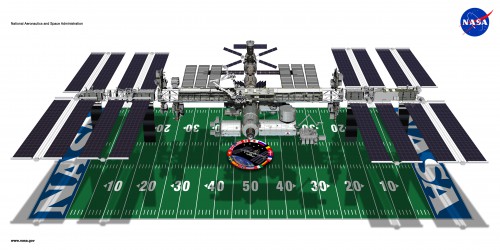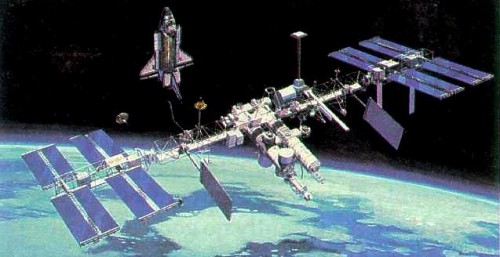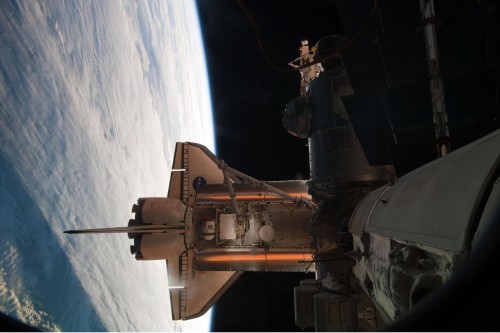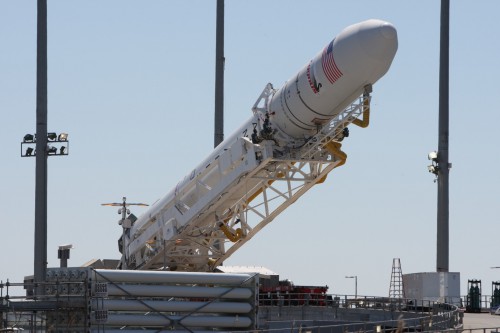
For a long time, it looked as if it would never happen: the Reagan-era Space Station Freedom was a victim of cutbacks, budget overruns, and a myriad of other issues, never to be designed as it originally was laid out. Enter 1993, and then-NASA Administrator Daniel Goldin announced the evolution of Freedom into what is now well-known as the International Space Station (ISS).
Construction of what we now know as the International Space Station began on-orbit in 1998. Its first long-duration crew came aboard two years later in 2000. In 2013, the multi-moduled, solar-paneled station is the largest visible satellite in the night sky and is currently helmed by the Canadian Space Agency’s (CSA) Col. Chris Hadfield. The space station is a collaboration between 16 different nations and has housed space travelers from NASA, Roskosmos, CSA, JAXA, and ESA. Taxpayers have sunk $100 billion into the orbiting laboratory.
The cost factor has come with criticism. The ISS took a long time—13 years—to construct. Its last module, the Permanent Multipurpose Module (PMM), was delivered to the station on Space Shuttle Discovery’s last flight, STS-133, in early 2011. Russia may add other modules in the future. The Centrifuge Accommodations Module, which would have provided for experiments in artificial gravity, was canceled in 2005 due to prohibitively high costs. This was also the fate, although it was later revived, of the Alpha Magnetic Spectrometer-02 (AMS-02), which is currently affixed to the space station’s truss assembly. As the United States’ economy experienced problems, the space program was scaled back.
One event that further altered the ISS’ trajectory was the loss of Space Shuttle Columbia and her crew in 2003. After much soul-searching, NASA’s path forward was dramatically altered.
In 2011, after 30 years, the Shuttle Program came to an end. All of the shuttles’ post-Columbia accident missions concerned ISS construction and completion. The shuttles were very expensive to maintain, experienced delays, and no doubt increased some of the total cost of the space station. (For the time being, astronauts catch a ride on Russian Soyuz capsules.) In the ISS’ history, 165 EVAs have been undertaken to fabricate and maintain the space station. Although viewed as dangerous in the early days of space flight, these “spacewalks” are fairly routine now.
Of course, one of the ISS’ reasons for existing is to advance science and spinoffs, therein making life better for people back on Earth. The canceled Centrifuge Accommodations Module reduced the station to working on experiments with easily available equipment. However, now that construction of the ISS is complete, in the last couple of years it has finally entered into its “extensive scientific phase.”

While some have argued that some of the experiments could possibly be replicated on, say, a “vomit comet” aircraft, there are experiments and discoveries that have taken place on the ISS not replicable within the bonds of Earth. Most of these discoveries have taken place recently—within the last five years.
It was found that bacteria become more aggressive and grow more quickly in space, which may lead to vaccines for potentially fatal illnesses plaguing people on terra firma (for example, salmonella bacteria was observed to display this phenomenon on the ISS in 2008). Studies on bone density loss in space are also being undertaken, which may help patients with osteoporosis on Earth. Information gleaned may also assist with future long-term space expeditions (missions to an asteroid or Mars are some examples). Astronauts on the ISS use the Advanced Resistive Exercise Device (ARED) to combat bone loss with frequent exercise, as well as eating a well-balanced diet and getting sufficient quantities of Vitamin D. Those observations “up there” might go a long way in helping mature citizens down here.
Just in the last year, the Alpha Magnetic Spectrometer-02 has collected particles that suggest, but don’t prove, the existence of dark matter. The AMS conducts its research by collecting positrons and electrons.
Crystal growth experiments continue, helping researchers on Earth understand structure and functions of proteins. Experiments in blood work and respiration are slated to be used on Earth to look for innovations in fighting chronic illnesses such as cancer and asthma.
Perhaps one of the most important tests of the human body—and science—on the ISS (and in spaceflight) will take place during 2015, when NASA astronaut Scott Kelly and Roskosmos’ Mikhail Kornienk are scheduled to spend a year on the space station, in part to see how the human body adapts to spaceflight beyond six months.
The ISS may also have a stake in how disaster readiness is utilized on Earth. Just weeks ago, the International Space Station SERVIR Environmental Research and Visualization System, or ISERV, premiered its “first light” image. This imaging system provides high-resolution glimpses upon our home planet and has the potential to save citizens from environmental disasters on a global scale.

In the past year, SpaceX demonstrated commercial delivery capabilities with its Dragon capsule delivering crucial supplies to the ISS. It demonstrated the ability to deliver science samples back to Earth, which speeds up scientific research time. This was especially true on the Commercial Resupply Services-2 mission conducted last month. One experiment in particular was flown up, conducted on station, and then returned to the Dragon capsule, which then delivered it back to scientists on Earth. Later this year, the Antares rocket system with Orbital’s Cygnus capsule will try to dock with the ISS and attempt a similar resupply mission. A demo is scheduled to launch from the NASA Wallops Flight Facility in Virginia Wednesday, April 17.
Moreover, the “international” aspect of the ISS promotes goodwill, as five space agencies have a financial stake in the project. It is, in part, a continuation of the Mir program (and, reaching back earlier, Apollo-Soyuz). Not least notably is the importance the ISS poses to school-age students. Students’ experiments from across the world have been undertaken on-board, most visibly with the YouTube Space Lab competition in 2012; this initiative ignites and maintains students’ passion for STEM subjects.
The ISS has issues that radically reduce what it is capable of on other fronts. To accommodate the Russians, the station was constructed in an orbit that restricts what it is able to do. Whereas, if it were in a more optimal orbit, it could have been used to assist in deep space exploration initiatives; its current orbit restricts it to mainly micro-gravity and some technical research.

Also while the Russians and certain commercial concerns want to keep the ISS on orbit past 2020, others have expressed an interest in crewed deep space exploration efforts. Reports have even suggested that some are considering the possibility of ending their involvement in the program.
While the ISS has been a magnet for criticism due to its lack of published science thus far, long building time, high costs, and need for continued maintenance, its $100 billion worth may be proven in the next few years, as it continues to shed light on Earth’s environmental and health problems while yielding discoveries about living and working in space. The ISS’ story is still being written. Hopefully, some of these lessons will be learned if the U.S. does head to an asteroid, the Moon (again), or Mars, and decides to build infrastructure on or near other worlds. So, will the ISS provide a return on the investment it took to construct it? Perhaps—if it survives the ever-changing political landscape and produces discoveries that can be hung from its arrays, spires, and trusses like medals, it will prove its worth. If not, then the greatest construction effort in human history will go down as a mistake. Time will tell.




Nancy Atkinson has written a wonderful article on Universe Today, back in 2008, of why the ISS is worth it!
http://www.universetoday.com/12815/i-heart-the-iss-ten-reasons-to-love-the-international-space-station/
Excellent piece. I think far too many space enthusiasts take “most expensive construction project” to automatically mean “most useful” without really weighing the pros and cons of the station itself.
A lot of the work done on the ISS could have been done on Shuttle flights and unmanned satellite microlabs, so I think the real necessity of it is yet to be seen.
A manned space station should first and foremost be used to further the frontier, but so far, most of the human spaceflight applications tested are things that have been tested and understood after dozens and dozens of spaceflights. Everyone already knows what’s going to happen to Scott Kelly after a year in space, I’m surprised he would even volunteer for it.
Now if they were to test a centrifugal living space sized module in order to try out the tech we’re actually going to need to keep humans healthy and able-bodied on long trips to other planets, then I would say hands down it’s worth it. But until NASA gets up the gumption to test that one out, I think this will remain just a feather in NASA’s cap.
Brian,
Please define “A manned space station should first and foremost be used to further the frontier.” What does that mean?
To push human beings further out into space by testing the tech that we will need to do it. If we can’t use it as a building or launching platform to deep space missions, we can at least test out technologies that will pull down the barriers that are keeping those missions too dangerous or costly to seriously fund.
Here is the problem with that statement Brian – technology development is NOT the only problem we’ll have to deal with when it comes to the issue of expanding the frontier. There are sociological, economic, and governance issues that needed to be developed.
To miss this will result in not actually furthering the frontier (we’ve spent how many years chasing cheap access without understanding its not just a technical issue)
While one can argue the many pro’s and con’s of the ISS, my question is: “What happens if we simply de-orbit the station and leave no permanent presence in space?” Is THAT the answer? No, I think not! If we don’t maintain and improve upon the station’s capabilities, another nation (I.e., China) will fill the void. Remember, what is spent on space exploration is “chump change” compared to the enormous wasteful spending in other ateas.
Tom, I don’t think that’s a winning argument. Imagine if I told a business owner. “Yes, my poor management ran your business into bankruptcy, but that’s chump change compared to what the government wastes.”
The appropriate comparison is what it would cost for similar capabilities. $100b in that case might be 1.5 to 2 magnitudes more than it might have cost if done another way.
I think it is an engineering accomplishment–but an HLLV would have allowed a more roomy station to be had faster with less assembly.
$50 billion and counting…
What was the return on investment? The article doesn’t really say.
The ISS is more about human ego than science or business.
I wish they had spent that money on feeding people or fixing bridges.
Hi Rich,
While I respect your opinion. You’re making a flawed, emotional argument. The mission of the ISS is to help humanity to learn how to become a space-faring species. Moreover, ISS does research into finding a cure for cancer, how to grow stronger crops & much, much more. Also, NASA’s budget is under $18 billion a year. As long as there are people there will be war, disease & famine. Eighteen billion – quadrupled wouldn’t begin to make a dent in these problems which have been around since the beginning of time.
Earth’s shelf life is getting shorter each day as people overpopulate the globe & use up non-renewable resources. We need to expand past the confines of Earth if we’re to survive. Your argument is we should sacrifice humanity’s long-term survival for a futile, feel-good gesture that would do absolutely nothing to address the root causes of the issues you highlight. We need to increase the amount we spend on space exploration – not reduce it.
Sincerely, Jason Rhian – Editor, AmericaSpace
The International Space Station(ISS)is the White Elephant of the 21st Century; a colossal waste of time & money. Nasa is a disgrace and should be part of the State Department as they are lackeys to The President, rather than a true agency involved in Science and Research. (Read “Star Crossed Orbits” for the true origins of the ISS).We had the plan in place, written in the 1950s by Dr Werner Von Braun to go to the Moon and then the planets. After we proved Man could live & work in space in the 1960s, we went 2 the Moon, the plans were halted as there was no longer any real leadership in Washington. The President was Nixon who was a mindless booby more concerned with how he was going to look in history 100 years from now than actually doing anything. He was a liar and a hypocrite and fortunately he was found out & thrown out of office. But leaderless, NASA floundered after Apollo was cancelled (they say 4 lack of funds but Defense has always spent > Science in the USA budget, & when Nixon cancelled Apollo the budget actually had a surplus of several BILLION $). For 40 years we did nothing, and planned a Space Shuttle to no where. We had the greatest boosters the world ever saw, the Saturn 5, and rather than use them they became tourist come-ons at space parks. The Russians did research in Space stations that were a fraction of the size the USA threw up(we launched just ONE Skylab) with one Saturn 5 booster( remember we had the boosters, they rot today as tourist attractions). The Space Shuttle was supposed to reduce the cost of throwing payload up to orbit, and be re-usable, every 2 weeks. The reality was the Shuttle was 10X more expensive to use then the Saturn 5 boosters and was “retired” only after we lost two to avoidable accidents, and the turn around was many months rather than 2 weeks: and it was a ride to no where! The next boondoggle was the ISS. It is a total waste of money, with the most expensive labs in the universe to conduct needless experiments. We have 40 years of data to show that we loose calcium in ZERO G, we don;t need more experiments, we have submarine crews who can spend a year in a sub cruising beneath the sea ice.. we don;t need experiments in long term isolation, and it continues. WE could have gone to Mars 15X for what we have spent on the ISS that goes NO PLACE. Is it any wonder our gov’t is bankrupt when it continues useless programs like the Shuttle and the ISS?.Soon we shall be a 3rd power, broke and behind in technology, education, gross earnings per capita, etc. Enough ISS…lets get on to Mars the cheap way as explained by Dr Zubin and the Mars Scociety (read ” The Case for Mars” by Dr Zubin). Lets get off this planet before the Rockefelelrs, Masons, Rothschilds, Bilderbergers etc…take over…!!!